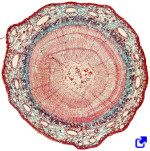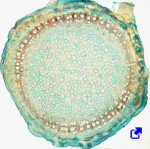The secondary growth of the stem is due to the activity of the vascular cambium meristem and cork meristem. It is a growth in thickness, not in length. Secondary growth is a feature of gymnosperms and many dicot plants (dicot woody plants). Only a few monocot plants show atypical secondary growth, and none are pteridophytes (ferns and the like).
During the primary to secondary growth transition, the first thing to happen is the formation of the vascular cambium meristem, differentiated from both the procambium and from the dedifferentiation of the interfascicular parenchyma (Figure 1). The fully developed vascular cambium is a cylinder that, through proliferation and differentiation, gives secondary phloem outward and secondary xylem inward. In this way, the former primary vascular tissues, primary xylem and primary phloem, are pushed away from each other and remain as small groups of cells at the surfaces of the secondary vascular tissues, sometimes as nail-like structures.

The activity of the vascular cambium leaves a growing ring every year, which is left inner as the meristem moves away from the central axis of the stem. This mechanism produces the growth in the thickness of the stem. The older differentiated cells from the vascular cambium are the innermost cells of the stem (the inner rings), whereas the more recent differentiated cells are those closer to the meristem. In woody stems, another outer meristem known as the phellogen or cork cambium produces the periderm, or bark, which replaces the epidermis.
In herbaceous dicot plants, the vascular cambium does not usually form tissues organized along the whole circumference of the meristem. In these species, it is the procambium (fascicular cambium) that forms the vascular bundles, whereas the interfascicular parenchyma gives a specialized cell type known as fibers. Hence, the secondary xylem is not a continuous ring of tissue but an alternation of vascular tissue and supporting tissue. In other species, like in vine, the interfascicular parenchyma gives more parenchyma.
The following structures are observed in a stem undergoing secondary growth, from outside to inside (Figure 2):

Periderm
The periderm differentiates from the lateral meristem phellogen or cork cambium. It is present in the stems showing a well-developed secondary growth. In some species, both vascular cambium and cork cambium appear at the same time at the beginning of the secondary growth, but it cork cambium appears more often after the vascular cambium.
In most plants found in temperate latitudes, the first periderm lasts for only a few years, and then a new inner periderm is formed. If the periderm is continuous along the stem perimeter, the stem surface is smooth. In other plants, the formation of periderm occurs in patches, leading to lens- or shell-like structures that overlap with each other. In theses, the cork cambium is derived from the cortical parenchyma. The broken surface and streaks seen on the surface of the stems are a consequence of the outward pressure of the radial growth of the vascular cambium.
The outer part of the periderm is the cork, or phellem, which becomes part of the bark of the stem. The periderm is the outer part of the stem and functions as a protective structure. However, the "real" cork is a tissue found to be more superficial than the vascular cambium, including the secondary phloem and periderm. Thus, it is the result of the activity of the two meristems: the vascular cambium and the cork cambium. The cork cambium is a transient meristem in many trees since it disappears and is then generated again in each cycle of growth of the periderm. The successive periderms that have been formed and stay in the stem are known as the ritidome (Figure 3). Hence, the bark is formed of phloem, periderm, and ritidome. There is no ritidome in those species that keep the same cork cambium throughout their whole lives. Trees, vines of the jungle, and old bushes show an inner and an outer bark. The inner part contains the secondary phloem, and the outer one contains the peridermis and ritidome when present. There are living cells in both parts.

The bark may account for 9 to 15 % of the stem volume. It performs many functions, such as storing water or organic substances, protection against fast temperature variations, protection against mechanical damages, herbivores, pathogens, dehydration, sun irradiation, strong wind, flooding, and many other potential damages.

Some species develop stem bark with significant commercial interest, such as the cork oak (Quercus suber). This species shows a stem without ritidome; that is, the cork cambium is permanent. Without layers, it produces a homogeneous material. On the other hand, trees with ritidome show alternate layers of parenchyma and phloem, so that the bark is ground and used as agglomerated. The cork oak is an interesting species because once the periderm is removed, the stem produces a new cork cambium with similar features to the previous one. That is why cork can be obtained during the entire lifetime of the tree.
Vascular tissue
The secondary phloem is produced by the vascular cambium toward the outer surface. The older secondary phloem is always more superficial than the younger one. The older secondary phloem degenerates progressively and is included in the stem bark. The new secondary phloem is closer to the vascular cambium, and it is composed of parenchyma cells, sieve tubes, and companion cells. The functional secondary phloem, conducting tissue, is found near the vascular cambium, while the older one loses this function because sieve cells lack intracellular content.
The vascular cambium is a lateral meristem responsible for the formation of secondary xylem and secondary phloem. It is composed of undifferentiated cells organized in rows parallel to the surface of the shoot.

The secondary xylem is the tissue that forms the wood. Everything below the vascular cambium is generally called wood. The vascular cambium forms the growth rings of the stems. The inner part of growth rings usually has larger cells than the superficial part. They are known as early and late wood, respectively. In warm-weather regions, where seasons are clearly different, growth rings are annual. However, in tropical regions, the growth rings correspond to rainy periods and are not much influenced by temperature or the photoperiod. Hence, there is no direct correspondence between time and the growth rings. Some events, like fire or the loss of leaves, may produce more than one growth ring per year in species in warm-weather regions. These are known as false rings. Regarding the cell morphology, there are ring-porous stems if the growth rings have larger cells in the inner part and smaller cells in the outer one, and diffuse-porous stems when all cells show similar size. There are examples with intermediate features between both types. The ring-porous feature is thought to be more evolved than the diffuse-porous organization.

The secondary xylem differentiates from the vascular cambium toward the interior of the stem. The secondary xylem of angiosperms is composed of traqueae, tracheids, sclerenchyma fibers, and parenchyma cells. The new xylem, closer to the meristem, contains living cells that conduct substances. The inner part of the secondary xylem is dead tissue and does not conduct anything. As the secondary xylem layers get older, parenchyma cells die, and the chemical composition of the cell walls of the xylem cells changes; that is, the wood is modified. Storing substances are removed, and cells are infiltrated with oils, tannins, or resins. Sapwood is the region that performs conduction, and heartwood is the non-conducting wood, which represents the majority of the wood in thick stems. The thickness of sapwood depends on the plant species. For example, maple and ash trees show wide sapwood, whereas yew is thinner. Sometimes, it is difficult to distinguish the border between sapwood and heartwood. Waste products progressively accumulate in the sapwood. In angiosperms, but not in gymnosperms, parenchyma cells outgrow cytoplasmic expansions into the interior of the tracheae for storing waste substances, which will be part of the heartwood. These expansions are known as tyloses. The cell expansions enter through the cell wall pores, and a trachea may have been invaded by several parenchyma cells. These parenchyma cells store abundant waste products and eventually die.
Pith
The pith, or medulla, is the tissue found in the inner part of the stem, composed of parenchyma cells. The pith is surrounded by primary xylem. In woody stems, it is death tissue and is a few millimeters in diameter. However, many plant species show vascular tissue in the inner part of the stem, so they lack pith.
There is a non-conventional secondary growth that does not depend on the vascular cambium or cork cambium activities. It is produced by cell proliferation scattered through the stem. This atypical secondary growth is known as diffuse secondary growth, which is observed in palms and some tuberous plants.